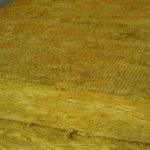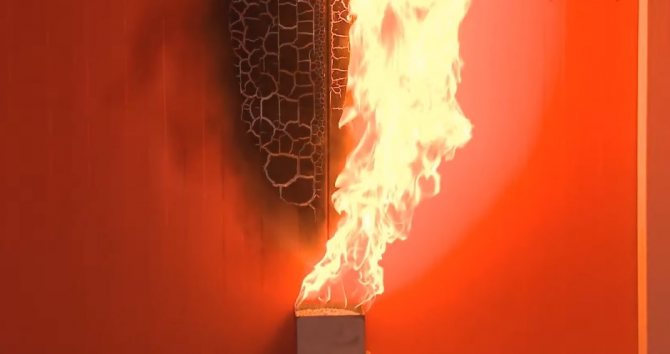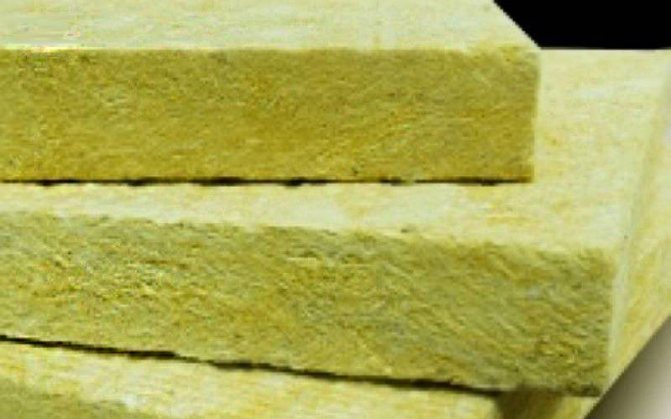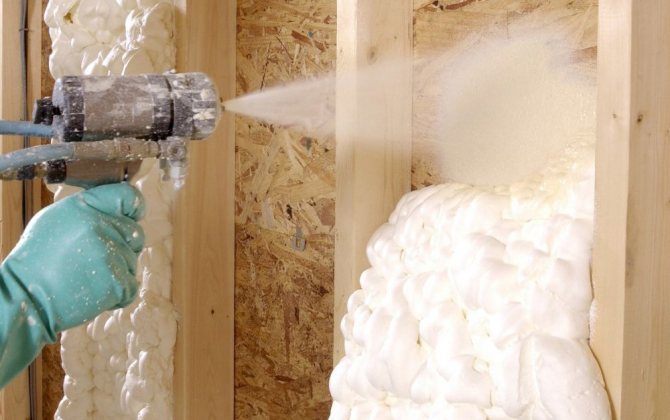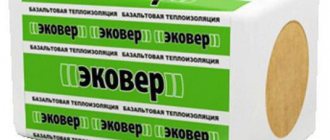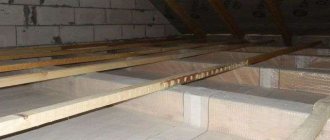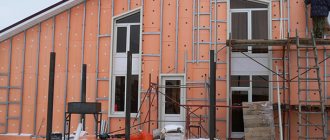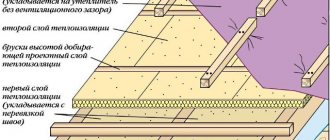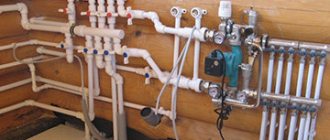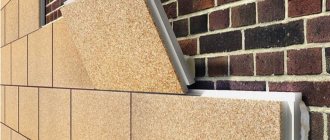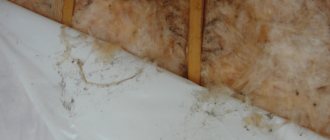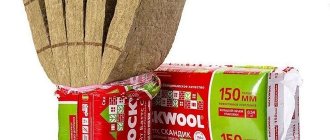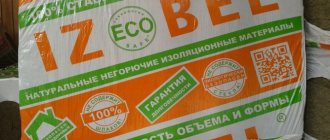Forms of mineral wool thermal insulation materials
Almost any kind of mineral wool can be produced in various forms, which compensates for the initial shortcomings of the material and makes it convenient to use for certain purposes. The list of the most common ones is as follows:
- Plates. Compressed mineral wool can be in the form of rigid plates, which are convenient to use as part of the currently popular sandwich insulation systems.
- Double-layer slabs. In this case, the first layer has a supporting function, imparting additional rigidity to the material, while the second (inner) layer provides the main thermal insulation. Excellent for external insulation, especially in combination with decorative or heat-insulating plaster.
- Lamellar plates. A feature of this format is the perpendicular arrangement of the fibers relative to the surface plane. As a result, the heat-insulating properties are somewhat narrowed, but the material acquires greater plasticity, which makes it possible to actively use it when insulating surfaces of complex shapes.
- Laminated slabs. Such products are coated on one side with a layer of polymer or fiberglass, which gives the material additional protection against destruction under the influence of air currents and condensation. Also often used in sandwich systems.
- Plates with a foil layer. A layer of foil, fixed with fiberglass mesh, acts as a vapor barrier required for external insulation.
- Wired mats. This flexible material is most often suitable for thermal insulation of attics and attic spaces. Before use, rolls of stitching mats must be left unfolded for some time to take their original shape.
- Mineral wool granules. Scraps from the production of one type of rockwool can also be a good insulation material. They find their application in specific blown insulation, which is implemented in the event that it is not possible to dismantle the decorative wall decoration.
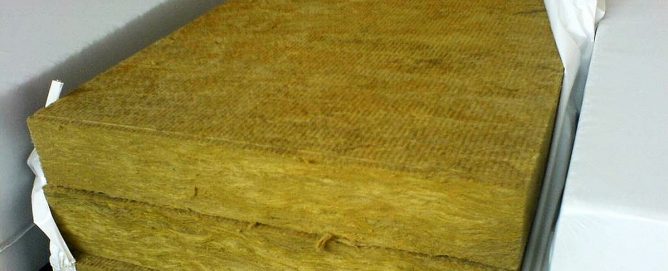
About brands of mineral wool and where each of them is used
Mineral wool is produced in the form of slabs and mats. They are used to insulate roofs, ceilings and floors, internal walls and partitions. You can work with both flat and non-standard surfaces. Difficulties when using this material usually do not arise. Since the density of mineral wool can be different, in accordance with this parameter, several grades of it are distinguished. Further details about each of them.
Mineral wool brand P-75
The density of this material is 75 kilograms per cubic meter. It is well suited for insulating horizontal surfaces that are not exposed to heavy loads. In particular, these are attic spaces, as well as some types of roofing. To preserve heat, pipes of heating plants are also wrapped with cotton wool of this brand, as well as gas and oil pipes. Manufacturers produce mineral wool and lower density, but it can be used only where there are no loads at all.
Mineral wool brand P-125
A material with a density of 125 kilograms per cubic meter is suitable for floor or ceiling insulation, as well as partitions and walls inside the room. In low houses made of bricks, expanded clay concrete or aerated concrete, such wool can become the inner layer of a wall consisting of three layers. The material of this brand also has good sound insulation properties. Using it, you can not only insulate the building, but also protect against noise.
Minvata brand PZh-175
This material is not only dense, but also has increased rigidity. It is usually used for thermal insulation of floors and walls made of reinforced concrete or profiled sheet metal.
Minvata brand PPZh-200
This abbreviation means that a mineral wool slab has increased rigidity. It is used in the same cases as the previous brand. The only difference is that the PPZh-200 brand can also be used as additional protection against fire.
The attic is insulated with pieces of stone wool.
Additional modifications
When creating thermal insulation for inclined and vertical surfaces, a multilayer and rather complex system is performed, consisting of a windscreen, a moisture and vapor barrier.
Mineral wool with foil is great for preventing heat leakage as much as possible
To facilitate the installation of such a structure, special mats made of mineral fibers will help, which are equipped with additional layers, made according to the principle:
- lamination - fiberglass or polymer thin film prevents the blowing of fibers from the common layer by the wind;
- foiling - preventing moisture from entering the middle of the insulation, heat is retained in the room due to its reflection from the mirror surface;
- creating an external bituminous layer that acts as a waterproofing protection.
Mineral wool slabs are versatile and multifunctional, thanks to which they have found a huge scope of use. Knowing the elementary features and technical parameters, you can independently choose a heat insulator for arranging a living space.
Mineral wool board is a heat-insulating material made of mineral wool and a synthetic binder. The miniplate is resistant to high temperatures, and if it was made from natural rocks, they will begin to melt only after two hours of exposure to a temperature of a thousand degrees. In addition, the mineral wool board is resistant to most aggressive chemical substances: alkalis, oils, solvents. Mineral wool (mineral wool) slabs have different hardness and density. Another advantage is a high vapor permeability coefficient, which makes it possible to freely penetrate water vapor. This helps keep the material from moisture formation, which can lead to the spread of mold and various pests.
The advantages of a mineral wool board include the following: - Low moisture absorption - no more than 1.5%. - Complete incombustibility. - Ease and ease of use. The material does not need special fasteners, it is easy to cut and lay. - The fibrous structure provides elasticity and high strength to the material. - No deformation even under heavy loads. - Due to the fibrous structure, such a board is a good sound insulator. This quality is very useful in industrial construction, as the sound insulation properties help to reduce the thickness of the installed insulation. - Durability. The material performs its functions up to 25 years. - Environmental friendliness. - High thermal insulation properties.
Use of mineral wool boards
Mineral wool boards differ in the degree of hardness. This is how soft, semi-rigid and hard slabs are distinguished. In construction, semi-rigid and rigid ones are more often used: the former for thermal insulation of wall partitions, roofs and in multilayer systems, and the latter for thermal insulation of roofs, facades, floors. Soft slabs are mainly used for thermal insulation of communications.
- Residential construction. The miniplate is the most common insulation for the house, it is used to insulate all parts of the building, including the floor and basement. - Insulation of floors. - Warming of inter-rafter spaces. - Thermal insulation of the facade. - Insulation of the roof and attic. - Insulation of water supply and heating equipment, as well as plumbing equipment and pipelines.- Industrial engineering.
This material can be used both on newly built houses and on those already in use. Today, mineral wool slabs are the safest, most environmentally friendly and effective heat and sound insulator.
A few tips for choosing mineral wool
We list the manufacturers that produce excellent quality mineral wool. These are, in particular, "URSA", "ISOVER", "PAROC", "Rockwool". Mineral wool from Germany is considered one of the best. If you met her in a store, buy it boldly. After all, no other EU country has such picky certification bodies. So it's not for nothing that they say that German quality speaks for itself.
The cost of mineral wool depends on its density. The higher this indicator, the more difficult it is to manufacture the material, and the more starting material is required in its production. This is obvious - after all, with an increase in density, the number of fibers also increases.
Although slag and glass wool come in temptingly low prices, think carefully before purchasing them. These materials, and as sound insulators, are very mediocre, and they do not hold heat very well. But there are no problems during installation - if glass wool gets on the skin, the affected area will then become inflamed and itchy for a long time.
Check with your retailer for the direction of the grain of the material. If they run vertically, then the mineral wool will better conserve heat and protect from noise. When the fibers are arranged chaotically, the material becomes more durable, withstanding considerable dynamic loads.
Check whether this product is manufactured in accordance with GOST - this is indicated on the packaging. So, slabs of mineral wool are made in accordance with GOST 9573-96, stitched mats - in accordance with GOST 21880-94, and PPZh slabs - in accordance with GOST 22950-95.
Now about such an important detail as the size of the mineral wool. When you come to the store to buy this material, carefully study its characteristics, and then ask the seller to open the package. Do not listen to assurances that the size of the slabs is really 5 centimeters, no more and no less. Better to be convinced of this personally.
srbu.ru
Introduction to thermal conductivity
Adequate insulation of mineral wool board products, preventing heat leakage, is provided by a special fibrous structure. If we consider its specific indicators, then they depend on the purpose and type of material and vary from 0.036 to 0.042 W / (m * K). In this case, the temperature regime is represented by 10-25 ° C.
Fire resistance value
One of the rare distinguishing features of mineral wool is its resistance to fire. Used as an insulating layer for a living space, it will not ignite from an accidental spark or a short circuit in an electrical wire. In the event of a fire, it prevents the spread of fire.
Due to its properties, mineral wool is used to insulate rooms where various flammable substances are stored.
If we consider special basalt-containing products, then they can withstand the action of open fire (up to + 1000 ° C) for several hours, but provided that fillers based on synthetic combustible components were not used in the process of creating the plates.
Density indicators
Stiffness is an important indicator of mineral wool slabs, which, along with resistance to deformation changes against the background of external loads, depends on the density of the material. It is by density that it is customary to classify the described thermal insulation:
- hard slabs are represented by the brands PT-250, PT-220, PT-300, characterized by a value of 220-300 kg / m³;
- products with increased rigidity - brands ППЖ-200, ППЖ-180, ППЖ-160, strength index reaches 160-210 kg / m³;
- soft plates are presented with a density of 40-55 kg / m³, the most popular markings are PM-50, PM-40;
- rigid slabs - 100-150 kg / m³, the category includes brands ПЖ-120, ПЖ-100, ПЖ-140;
- semi-rigid devices for insulation - 60-90 kg / m³, marked PP-80, PP-70, PP-60.
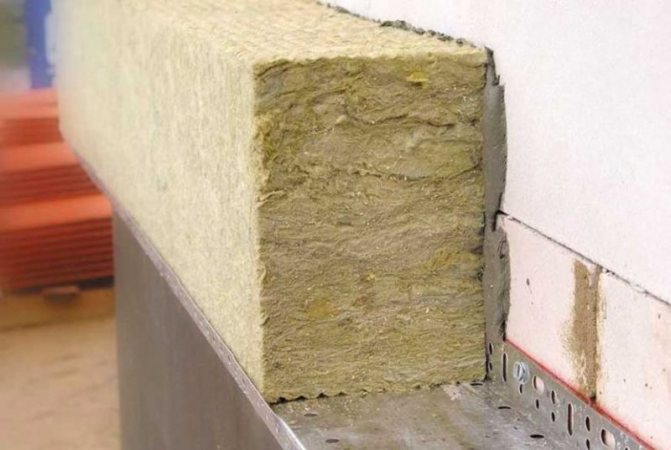

The density of the mineral wool is selected based on the area of its application.
Moisture resistance and vapor permeability
Mineral wool is capable of absorbing excess moisture, as a result of which its properties with respect to strength and durability deteriorate. But the replacement of liquid by air masses leads to a strong increase in thermal conductivity, therefore, the operational properties of the plates deteriorate.
The best option is the use of special fillers at the production stage, which hydrophobize the final product. The current GOST indicates that the level of moisture resistance of mineral wool boards should vary between 4-7 pH.


Mineral wool has excellent acoustic properties and allows you to improve airborne sound insulation of premises.
As for vapor permeability, mineral wool has the highest rate in comparison with other heaters - 480 × 10−6 g / (m × h × Pa). Insulating structures that do not have a vapor barrier (material for finishing external walls under plaster) or are equipped with a gas-permeable layer optimally preserve normal gas exchange. As a result, a favorable microclimate is created inside the room.
Technical parameters and types
Mats made from mineral fibers differ in technical characteristics that depend on the density of the product, the location of the fiber raw materials and the quality of the raw materials involved.
Experts advise, when choosing a heater, to take into account the specifics of the scope of application, to compare it with the properties of the required product.
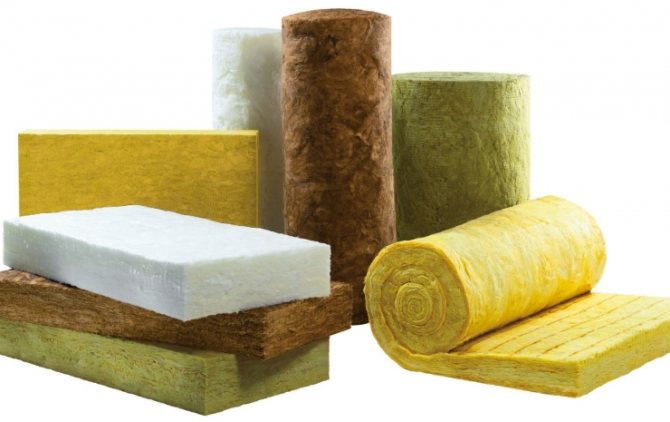

Experts advise, when choosing a heater, to take into account the specifics of the scope of application, to compare it with the properties of the required product
As for the variety of mineral slabs for the floor, ceiling and walls, it is represented by slag, glass wool and stone wool. It is worth dwelling on each option in more detail:
- Glass wool is the most affordable insulation in this series. The initial raw material is limestone, dolomite, soda, sand, borax. From all this, fiber is produced in 5-15 microns, reaching 15-50 mm in thickness. The permissible temperature range at which the material is allowed to be used varies from -60 to + 450 ° C. Over time, glass wool can cake, which leads to a decrease in its heat-shielding function. In the process of work, this fragile material breaks down, so it is imperative to use protective equipment. Prevention of glass dust entering the room is ensured by a special vapor barrier.
- Slag wool is distinguished by a low indicator of environmental safety, since it is produced from blast-furnace slag. Due to this feature, the insulation is not recommended for installation inside residential premises. The fiber reaches 4-12 microns in thickness, its length is 16 mm.
- The safest and most effective is the basalt version of mineral wool as a heat insulator. The material does not crumble, does not penetrate into the air inside the room, has high wear rates, is durable and fire-resistant. If phenol-formaldehyde resins are not involved in the production process, basalt slabs can be called completely environmentally friendly. Their significant drawback is their high price.
If we consider the structural feature of the miniplates, then they are distinguished by a chaotic or lamellar arrangement of fibers.
Glass wool.
For the production of glass wool, sand, limestone, borax (etibor) and soda are used - common components for the production of glass. All this is poured into a special hopper, where it melts at a temperature of about 1400 ° C, and then the resulting glass is passed through spinnerets and enters special centrifuges, where it is blown up with steam to obtain thin glass filaments.
The fiber formation process is accompanied by treatment with polymer binders. Then the resulting mass is molded and blown at a temperature of 250 ° C to dry and form polymer bonds. After polymerization, the wool fibers become hard and acquire an amber-yellow color. Then the cotton wool is cooled, cut and packaged.
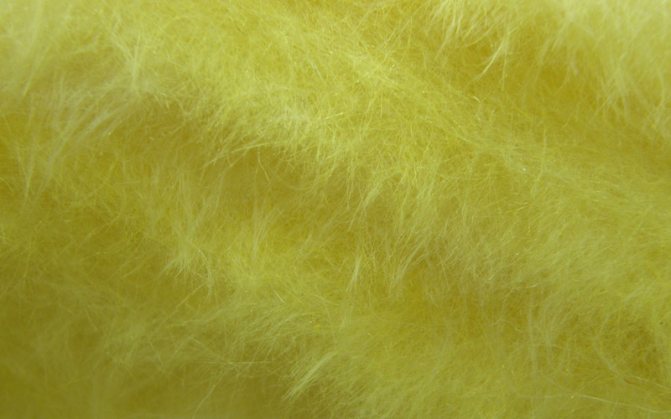

The thickness of the glass wool fibers is from 5 to 15 microns, and the length is from 15 to 50 mm. These fiber sizes impart mechanical strength, resilience and low thermal conductivity to glass wool. A layer of wool 5 cm thick in terms of thermal resistance corresponds to a brickwork 1 meter thick.
The temperature range at which glass wool retains its properties is from -60 to +450 ° C. The density does not exceed 130 kg / m3.
Benefits.
- Has good thermal conductivity: 0.038 - 0.046 W / m · K;
- Good sound absorption;
- Glass wool has a very high chemical resistance;
- Does not burn or smolder;
- It does not shrink during long-term operation, and its fibers do not collapse even with prolonged vibration.
- It absorbs sound well, is low-hygroscopic, frost-resistant.
- The strength of glass wool fibers is higher than that of basalt wool.
Disadvantages.
- The main disadvantage of glass wool is its high fiber fragility. These thin and sharp fragments of fibers easily penetrate the fabric of clothing and cause severe itching of the skin. It is highly undesirable to breathe air containing glass fiber particles. It is necessary to work with this material in overalls made of dense fabric, gloves, a respirator and goggles.
- Low heat resistance of glass wool. At temperatures above 450 ° C, it begins to break down and lose its properties.
Basically, glass wool is used for thermal insulation of structures with a surface temperature of -60 ° C to 450 ° C.
Construction insulation IZOMIN
On the basis of basalt fiber obtained by melting rocks, a wide range of heat and sound insulation products is produced for use in various structural elements (roofs, partitions, walls, floors, etc.) of buildings and structures for various purposes. The quality of the products fully complies with international standards. All IZOMIN products belong to the group of non-combustible materials and contain water-repellent additives. Products are packed in plastic wrap.
| Product name | Recommended area of application | Density (kg / m3) | Overall dimensions, mm) | Thermal conductivity at 250C (W / m • K), no more | Compressive strength at 10% linear deformation (kPa), not less | Water absorption at full immersion by volume (%), no more | Content of organic substances by weight, (%), no more | Moisture by mass (%), no more | Peel strength of layers (kPa), not less | Water vapor permeability (mg / m • h • Pa) | Flammability class according to GOST 30244 |
| Izomin Light | As unloaded heat and sound insulation of horizontal, vertical and inclined building envelopes of all types of buildings, including low-rise and cottage-type individual buildings. | 35 50 | 1000x500x50-200 1000x500x50-200 | 0.037 0.036 | — — | 2,0 2,0 | 2,5 2,5 | 1,0 1,0 | — — | 0,38 0,38 | NG NG |
| Izomin Kaviti | As unloaded heat and sound insulation of horizontal, vertical and inclined building enclosing structures of all types of buildings, including for the installation of floors, ceilings, internal partitions. As a heater in light frame-type enclosing structures. As a middle heat-insulating layer in three-layer lightweight walls of low-rise buildings made of bricks, expanded clay concrete, aerated concrete and other blocks. | 60 70 | 1000x500x50-200 1000x500x50-200 | 0,036 0,036 | 3,0 3,5 | 2,0 2,0 | 3,0 3,0 | 1,0 1,0 | — — | 0,38 0,38 | NG NG |
| Izomin Venti | From the outside of all types of buildings as a heat and sound insulation layer when installing facade structures with a ventilated gap. | 80 90 100 | 1000x500x50-200 1000x500x50-200 1000x500x50-200 | 0,035 0,035 0,035 | 6,0 17,5 20,0 | 1,5 1,5 1,5 | 3,5 3,5 3,5 | 1,0 1,0 1,0 | 2,5 5,0 5,5 | 0,37 0,37 0,37 | NG NG NG |
| Izomin Facade | On the outside of all types of buildings as a heat and sound insulation layer, followed by plastering or applying a protective covering layer. | 150 160 175 | 1000x500x20-100 1000x500x20-100 1000x500x20-100 | 0,037 0,037 0,038 | 40,0 50,0 60,0 | 1,5 1,5 1,5 | 4,5 4,5 4,5 | 1,0 1,0 1,0 | 10,0 11,0 12,0 | 0,37 0,37 0,37 | NG NG NG |
| Izomin Ruf-N | As a lower heat and sound insulation layer in multi-layer coatings of flat roofs, including when laying on a surface without a cement screed. It is recommended to use Izomin RUF-N plates in combination with Izomin RUF-V plates. | 110 120 130 | 1000x500x40-150 1000x500x40-150 1000x500x40-150 | 0,035 0,035 0,036 | 24,0 28,0 33,0 | 1,5 1,5 1,5 | 3,5 4,0 4,0 | 1,0 1,0 1,0 | 5,5 6,0 6,5 | 0,37 0,37 0,37 | NG NG NG |
| Isomin-Ruf | As a heat and sound insulation layer in flat roof coatings, including when laying on a surface without a cement screed. | 140 150 160 | 1000x500x40-120 1000x500x40-120 1000x500x40-120 | 0,037 0,037 0,037 | 35,0 40,0 50,0 | 1,5 1,5 1,5 | 4,5 4,5 4,5 | 1,0 1,0 1,0 | 7,5 8,0 9,0 | 0,37 0,37 0,37 | NG NG NG |
| Izomin Ruf-V | As an upper heat and sound insulation layer in multilayer coatings of flat roofs, including when laying on a surface without a cement screed. It is recommended to use Izomin RUF-V plates in combination with Izomin RUF-N plates. | 180 190 200 | 1000x500x30-60 1000x500x30-60 1000x500x30-60 | 0,038 0,038 0,038 | 62,0 65,0 70,0 | 1,5 1,5 1,5 | 4,5 4,5 4,5 | 1,0 1,0 1,0 | 10,0 11,0 12,0 | 0,37 0,37 0,37 | NG NG NG |
By agreement with the customer, it is possible to manufacture products of non-standard sizes, in the range of lengths up to 2000mm and widths up to 1000mm.
Slag wool.
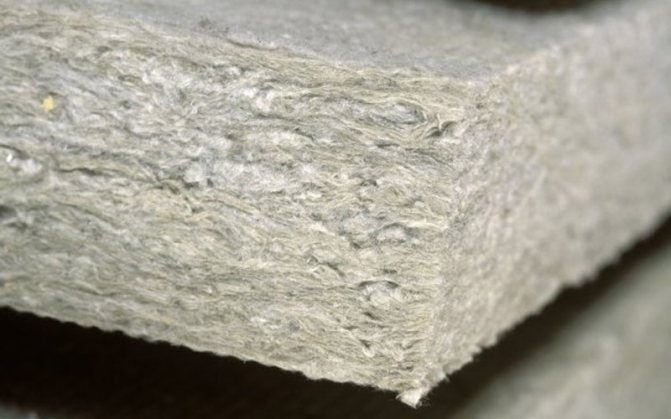

The raw material for the production of slag wool is slag waste from blast furnace metallurgy. The manufacturing technology is very similar to the stone wool production method.
The thickness of the fibers is slagged from 4 to 12 microns, the length is up to 16 mm. Density from 75 to 400 kg / m3.
disadvantages
- Sufficiently low maximum operating temperature up to 300 ° C. As the temperature rises, the fibers are sintered and lose their properties. By itself, the slag wool does not burn, but in the event of a fire, it will melt first.
- Not very good indicators of thermal conductivity 0.46 - 0.48 W / m · K;
- Not durable, service life 10 - 15 years, after which it collapses and loses its properties;
- Absorbs moisture well;
- It contains components with residual acidity, therefore, when moisture enters, the process of acid formation and the appearance of an aggressive environment for metals can begin. Therefore, it is not used where moisture may be present.
- The fibers are brittle and prickly, like steal fibers.
Advantages.
- The only advantage of this material is its low price. It was the most common insulation material in the Soviet past.
Currently, taking into account its shortcomings and the emergence of alternatives, it is rapidly losing its already insignificant position in the market of mineral insulation.
The table shows the comparative characteristics
different types of mineral wool.
| Characteristic | Slag | Glass wool | Stone wool |
| Thermal conductivity coefficient, W / (m2 * K) | 0,46 – 0,48 | 0,038 – 0,046 | 0,035 – 0,042 |
| Temperature range of use, ° С | — 60 … 250 | -60 … 450 | -180 … 600 |
| Fire resistance class (NG / G) | non-combustible | non-combustible | non-combustible |
| Sound absorption coefficient | 0,75 … 0,82 | 0,8 … 0,92 | 0,75 … 0,95 |
| Moisture absorption, (% of mass in 24 hours) | < 1,9 | < 1,7 | < 0,095 |
| Heat capacity, J / kg * K | 1000 | 1050 | 1050 |
| The amount of binding components,% by weight | 2,5 … 10 | 2,5 … 10 | 2,5 … 10 |
Comparative technical characteristics of the mineral slab
Today, a large number of reliable heat-shielding materials are produced. The table shows the technical characteristics of three common new generation insulators:
- synthetic polymeric foam boards;
- foamed polystyrene;
- mineral slabs for walls (facade) insulation "Isover".
| Indicators and Materials | Polyfoam PSB-S 15 | Foamed polystyrene plates Technoplex | Front plate Isover |
| Density, kg / m3 | 8-10 | 28-35 | 34-165 |
| Compression resistance, kPa | 500 | 250 | 45 |
| Flexural strength, MPa | 0,07 | 0,3-0,7 | — |
| Tensile strength, kPa | — | — | 4-15 |
| Thermal conductivity, W / m * K | 0,037 | 0,029 | 0,037-0,053 |
| Water absorption in 24 hours, kg / m2 | 0,01 | 0,2 | 1 |
| Flammability | G3 | G4 | incombustible |
| Additionally: average price per m2 | 34-84 | 198 | 140 |
Comparative analysis shows that, with similar indicators, mineral insulation is fire-resistant, differs in variability in density, has a better compressive ability, which is useful for packaging and transportation. The price of a min-plate (50 mm) Isover is preferable to the cost of the innovative expanded polystyrene Technoplex. The disadvantages include relatively high water absorption and large mass.
Which manufacturer should you choose?
Insulators of the Isover trademark are distinguished by innovative technologies for the manufacture of harmless, non-dusting cotton wool, combining softness, elasticity and strength. The company is the world leader in terms of production volumes and the only manufacturer of mineral wool boards represented in the Russian Federation.
Miniplates "Ursa" (the brand of the Spanish concern Uralita, which has 3 production sites in Russia) is versatility and the best performance: external and internal insulation of them is easy to install / dismantle; safety and durability. The structure of staple (cut) fiber conglomerates imparts special chemical and physical properties to thermal insulation layers made of Ursa mineral wool:
- low specific gravity;
- stability of strength indicators;
- plasticity of the surface.
Danish (literally, stone wool) is the oldest manufacturer of basalt wool (since 1937). Today there are more than 20 high-tech enterprises in 15 countries producing miniplates for any structures erected in residential and industrial construction.
Unlike fiberglass materials, the Rockwool mineral basalt slab is a volumetric canvas formed from randomly entangled fibers with numerous intersection points of the threads. This structure imparts strength and stability to the material with significant flexibility.
The cost
Average prices of the above brands are presented in the table:
| Name | Application | Dimensions, mm | Price per m2, rubles | ||
| Length | Width | Thickness | |||
| Isover (stone fiber) | |||||
| Isover Optimal | Non-stressed surfaces | 1000 | 500 | 100 | 199,58 |
| Isover Venti | Curtain facades | 1200 | 600 | 100 | 398,36 |
| Izover Facade | Facades for plastering | 1200 | 600 | 100 | 654,05 |
| Isover Ruf N Optimal | 1200 | 600 | 100 | 420,53 | |
| Ursa Geo (fiberglass) | |||||
| Ursa Geo Wireframe | Frame constructions | 1000 | 600 | 50 | 152,00 |
| Ursa Geo P-15 | Floors, partitions | 1250 | 600 | 50 | 70,00 |
| Ursa Geo (universal) | Walls for private housing | 1000 | 600 | 50 | 66,50 |
| Rockwool Mineral Slab | |||||
| Facade Butts | External walls, under plaster | 1000 | 600 | 50 | 343,75 |
| Light Butts Scandic | Thermal insulation universal | 1200 | 600 | 100 | 161,81 |
| Acoustic Butts | Internal sound insulation | 1000 | 600 | 50 | 111,50 |
The capabilities of the leading factories allow us to produce a wide range of standard sizes in a compact package that is easy to transport.
The cost of materials exceeds all other costs in the amount of financial costs for insulation. However, one should take into account the dependence of the total cost on the type of installation work. Spraying liquid foam per unit area, for example, costs 1200 rubles. Convenience and relative cheapness of the installation of mineral plates - from 80 rubles / m2 (floor sound insulation) to 300 rubles / m2 (roof protection) - makes their use most effective.
Basic properties
When choosing an insulation material for wall, floor, ceiling and roof surfaces, it is worth taking into account its thermal insulation performance.
Of no small importance is the class of fire resistance, vapor permeability, resistance to moisture. In all these respects, mineral wool outperforms many competing materials, and it also belongs to the budget category.
In all these respects, mineral wool outperforms many competing materials, and it also belongs to the budget category.
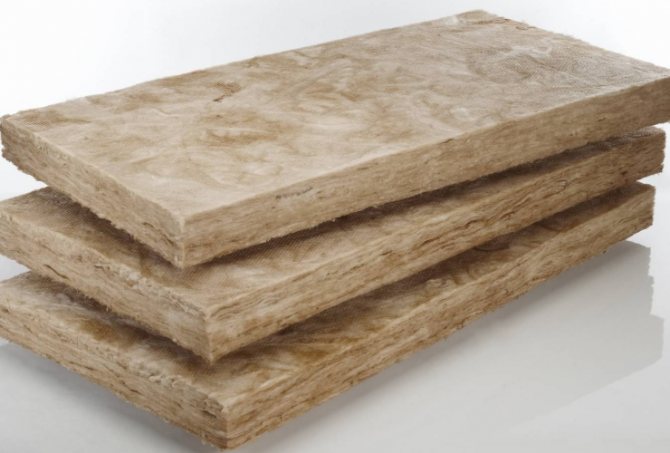

Mineral wool slabs are often used to insulate ceilings, ceilings, walls, and roofs
When starting the choice of mineral wool insulation, it is necessary to understand the main criteria by which its suitability for use in certain conditions is assessed. The fibers of the material have a number of advantages:
high strength, which is influenced by the density of the slab; insignificant weight, which is very important in preventing overloading of the created structure; prevention of rotting processes and the formation of fungi; scaring away small pests; fire resistance; service life up to 50 years.
Stone wool - the optimal heat insulator
Among all the listed varieties of mineral wool, stone wool is considered the safest, including with respect to flammability. Fibers of the material are similar in size to slag fibers, but unlike the first ones, they are not at all dangerous, they do not require special protection during installation.
The thermal conductivity of stone wool is minimal, and the melting point reaches 600 degrees Celsius.
An improved version of stone wool is gabbro or diabase basalt insulation. Unlike stone, basalt additionally includes blast-furnace slags and mineral components:
- dolomite;
- clay;
- limestone.
Due to impurities, the insulation demonstrates higher flow rates. In addition, there is almost no formaldehyde resin in basalt mineral wool, which reduces the risk of phenol evaporation, albeit against the background of a decrease in the ability to withstand moisture.
Since there are almost no components unstable to high temperatures in basalt mineral wool, the material is able to retain its functionality when heated to 1000 degrees Celsius.
Both stone mineral wool and basalt, at the melting temperatures declared by the manufacturer, do not burn, but only melt, which cannot be said about glass and slag wool.
Correct meaning of markings
The current standards and regulations assume the separation of mineral wool boards. Their subspecies are marked with the corresponding marks:
- Insulation P-150 is applicable as sound and heat insulation of the roof, has a high rate of fire resistance. Compression coefficient parameter is 2%, strength - 0.01 MPa and more, density - 150 kg / m³.
- The PP-125 value is used to mark the slabs of the semi-rigid type. Their main purpose is to insulate attic structures and pitched roofs. The material has a density of 125 kg / m³ and a compression of 12%, while the thermal conductivity is 0.049 W / mK.
- Rigid heat insulator plates are represented by the brands ППЖ-200, ПЖ-175. The maximum permissible load reaches 175 and 200 kg / m³, which makes the material suitable for the construction of flat roofs, which are subject to strong deformation loads.
When purchasing mineral wool, pay attention to its marking - the thickness, density of the material depends on it
Mineral wool brands P-100, P-150, PPZh-200
Today, manufacturers produce mineral wool in the form of rolls, plates and mats. This material successfully insulates the roof, ceilings and attic floors of the house. Difficulties in using and laying the material will not arise, even for an inexperienced person. Depending on the purpose of the material, the density of basalt wool can be different, several brands are distinguished in accordance with its density.
Mineral wool P-75
The density of the mineral wool is 75 kilograms per cubic meter. meter. The characteristics of P-75 mineral wool are only suitable for laying on horizontal surfaces that are not subject to loads. For example, ground floor floors, attics and flat roof views. The grade of basalt mineral wool P-75 is used for thermal insulation of pipes of heating plants, gas and oil pipes. Cotton wool of lower density is used where there are no loads.
Mineral wool P-125
The density of the mineral wool is 125 kilograms per cubic meter. meter. The characteristics of P-125 mineral wool have good performance in sound insulation, the material is suitable for laying on the floor and ceiling, thermal insulation of internal partitions. It is also used as thermal insulation inside walls made of foam concrete or aerated concrete. Using mineral wool P-125, you can insulate the facade with high quality and get excellent sound insulation.
Mineral wool ПЖ-175, ППЖ-200
The density of the mineral wool is 175 and 200 kilograms per cubic meter. meter respectively. This insulation is dense and has increased rigidity, which is reflected in the abbreviation RV and RV. Cotton wool is used for thermal insulation of interfloor floors and reinforced concrete walls. Due to the refractory characteristics of mineral wool PPZh-200 and PZh-175, it can be used as protection of residential premises from fire.
Tips for choosing mineral wool for home insulation
Worldwide, "ISOVER", "KNAUF", "ISOROK", "ROCKWOOL", "TECHNONICOL" produce excellent quality mineral wool. The cost of the material depends on its density, becausethe higher this indicator, the more the starting material is required for production. Mineral wool slabs are produced in Russia in accordance with GOST 9573-96, PPZh slabs (increased rigidity) in accordance with GOST 22950-95, and stitched mats in accordance with GOST 21880-94.
Arriving at a hardware store, carefully study all the characteristics of mineral wool. If the fibers are arranged vertically in the plates, then the material conserves heat better, if the fibers are randomly arranged, then the material will be more durable. Slag wool and glass wool have low prices, but if the fibers of the glass wool get on the skin, the affected area will be irritated and may itch for a long time, causing inconvenience.
pro-thermal insulation.rf
Do-it-yourself house facade decor ideas
House facade decoration is an individual task for each owner. Someone will stop at traditional plaster or frame framing. The more progressive part will use design solutions for decorating with stucco molding. Currently, the facades of houses with a bay window are in demand.
A bay window is a part of the facade protruding beyond the wall plane, fully or partially glazed. For the decoration of such a part of the building, stucco molding is used, which frames the entire perimeter of the glazing. Under the bay window, you can install two decorative consoles, it will turn out like a box in a theater.
Everyone can find a way to decorate the facade of a house with their own hands. To do this, you can use catalogs in magazines or specialized sites on the Internet.
Advantages of slab insulation
The characteristics of hard mineral wool boards indicate their excellent exploitation properties. Due to the isolated structure, the shape is well maintained, and the product itself, if necessary, can be easily processed (cutting, drilling).
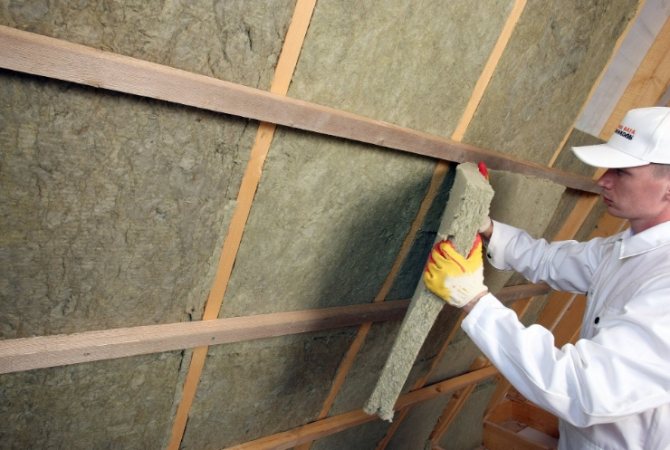

Thanks to mineral wool, you can improve sound insulation, retain heat in the room and significantly reduce heating costs
If we talk about the external arrangement of the roof, then mineral wool heat-insulating rigid plates on a synthetic binder are mounted on a previously prepared plane using special fasteners or fixing glue. On the street walls under the plaster, the mineral wool is attached with special devices equipped with umbrella hats. An indisputable plus of the described non-combustible heat insulator lies in its affordable cost.
Areas of use
During the production of mineral wool, blast furnace slags, glass, rocks of volcanic origin are involved. From the prepared melt, processed in special centrifuges, fibers are made, which are then mixed with synthetic-based binders. The mass obtained in this way is formed into plates that are convenient for use, differing in such parameters as stiffness, density, and overall dimensions.
The resulting material based on mineral fibers is suitable for providing reliable sound and heat insulation:
- three-layer panels, roofing structures;
- overlappings;
- ceilings;
- pitched or flat roofs;
- floor coverings;
- partitions;
- load-bearing strong walls;
- three-layer special walls, built of blocks, inside which the mineral wool is placed.
Non-combustible insulation for the chimney - basalt wool


The main purpose of the chimney is to provide the home with heat. But many owners do not realize that chimneys also need insulation, and this can be done independently by choosing one of the methods below.
The choice of a method and non-combustible material for insulating a chimney depends on factors such as the experience of the person who will be lining, the type of heat insulator and the type of chimney.
